
Op art, short for optical art, is a style of visual art that uses optical illusions.

Depth perception is the visual ability to perceive the world in three dimensions (3D) and the distance of an object. Depth sensation is the corresponding term for non-human animals, since although it is known that they can sense the distance of an object, it is not known whether they perceive it in the same subjective way that humans do.
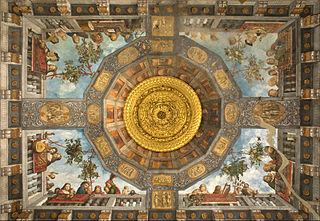
Trompe-l'œil is an art technique that uses realistic imagery to create the optical illusion that the depicted objects exist in three dimensions. Forced perspective is a comparable illusion in architecture.
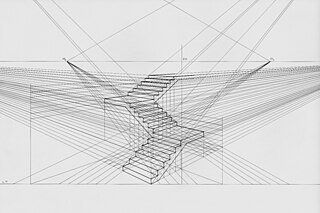
Linear or point-projection perspective is one of two types of graphical projection perspective in the graphic arts; the other is parallel projection. Linear perspective is an approximate representation, generally on a flat surface, of an image as it is seen by the eye. The most characteristic features of linear perspective are that objects appear smaller as their distance from the observer increases, and that they are subject to foreshortening, meaning that an object's dimensions along the line of sight appear shorter than its dimensions across the line of sight. All objects will recede to points in the distance, usually along the horizon line, but also above and below the horizon line depending on the view used.
Al Held was an American Abstract expressionist painter. He was particularly well known for his large scale Hard-edge paintings. As an artist, multiple stylistic changes occurred throughout his career, however, none of these occurred at the same time as any popular emerging style or acted against a particular art form. In the 1950s his style reflected the abstract expressionist tone and then transitioned to a geometric style in the 1960s. During the 1980s, there was a shift into painting that emphasized bright geometric space that's deepness reflected infinity. From 1963 to 1980 he was a professor of art at Yale University.

Illusionistic ceiling painting, which includes the techniques of perspective di sotto in sù and quadratura, is the tradition in Renaissance, Baroque and Rococo art in which trompe-l'œil, perspective tools such as foreshortening, and other spatial effects are used to create the illusion of three-dimensional space on an otherwise two-dimensional or mostly flat ceiling surface above the viewer. It is frequently used to create the illusion of an open sky, such as with the oculus in Andrea Mantegna's Camera degli Sposi, or the illusion of an architectural space such as the cupola, one of Andrea Pozzo's frescoes in Sant'Ignazio, Rome. Illusionistic ceiling painting belongs to the general class of illusionism in art, designed to create accurate representations of reality.

Anamorphosis is a distorted projection requiring the viewer to occupy a specific vantage point, use special devices, or both to view a recognizable image. It is used in painting, photography, sculpture and installation, toys, and film special effects. The word is derived from the Greek prefix ana-, meaning "back" or "again", and the word morphe, meaning "shape" or "form". Extreme anamorphosis has been used by artists to disguise caricatures, erotic and scatological scenes, and other furtive images from a casual spectator, while revealing an undistorted image to the knowledgeable viewer.
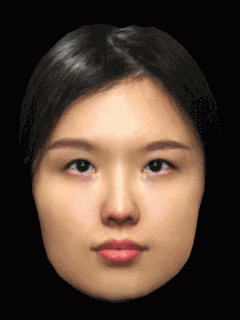
The Hollow-Face illusion is an optical illusion in which the perception of a concave mask of a face appears as a normal convex face.

Anne Redpath (1895–1965) was a Scottish artist whose vivid domestic still lifes are among her best-known works.
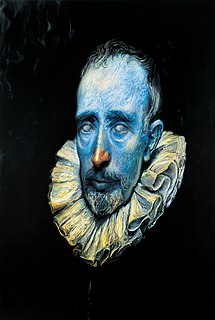
Glenn Brown is a British artist known for the use of appropriation in his paintings. Starting with reproductions from other artists' works, Glenn Brown transforms the appropriated image by changing its colour, position, orientation, height and width relationship, mood and/or size. Despite these changes, he has occasionally been accused of plagiarism.
Phantograms, also known as Phantaglyphs, Op-Ups, free-standing anaglyphs, levitated images, and book anaglyphs, are a form of optical illusion. Phantograms use perspectival anamorphosis to produce a 2D image that is distorted in a particular way so as to appear, to a viewer at a particular vantage point, three-dimensional, standing above or recessed into a flat surface. The illusion of depth and perspective is heightened by stereoscopy techniques; a combination of two images, most typically but not necessarily an anaglyph. With common (red–cyan) 3D glasses, the viewer's vision is segregated so that each eye sees a different image.

Ronald "Ron" Davis is an American painter whose work is associated with geometric abstraction, abstract illusionism, lyrical abstraction, hard-edge painting, shaped canvas painting, color field painting, and 3D computer graphics. He is a veteran of nearly seventy solo exhibitions and hundreds of group exhibitions.

Illusionism in art history means either the artistic tradition in which artists create a work of art that appears to share the physical space with the viewer or more broadly the attempt to represent physical appearances precisely – also called mimesis. The term realist may be used in this sense, but that also has rather different meanings in art, as it is also used to cover the choice of ordinary everyday subject-matter, and avoiding idealizing subjects. Illusionism encompasses a long history, from the deceptions of Zeuxis and Parrhasius to the works of muralist Richard Haas in the twentieth century, that includes trompe-l'œil, anamorphosis, optical art, abstract illusionism, and illusionistic ceiling painting techniques such as di sotto in sù and quadratura. Sculptural illusionism includes works, often painted, that appear real from a distance. Other forms, such as the illusionistic tradition in the theatre, and Samuel van Hoogstraten's "peepshow"-boxes from the seventeenth century, combine illusionistic techniques and media.

The Garden at Sainte-Adresse is a painting by the French impressionist painter Claude Monet.. The painting was acquired by the Metropolitan Museum of Art after an auction sale at Christie's in December 1967, under the French title La terrasse à Sainte-Adresse. The painting was exhibited at the 4th Impressionist exhibition, Paris, April 10–May 11, 1879, as no. 157 under the title Jardin à Sainte-Adresse.
In art criticism of the 1960s and 1970s, flatness described the smoothness and absence of curvature or surface detail of a two-dimensional work of art.

Michael James Kidner was a pioneer of Op art in the mid-1960s from Kettering, Northamptonshire, England. Michael Kidner was one of its earliest and most consistent exponents and it was in these overlapping fields of optical effect and systemic structure that he was to find the creative substance that was to sustain his whole career. A Constructivist by inclination his interest in mathematics, chaos and wave theories informed an art that is both rational and intuitive. Without losing his rigorous, intellectual approach, Kidner manages to make his work resonate emotionally.Throughout his life he retained an interest in unpredictable world events that provoked unplanned elements within his work but he somehow managed to intimate an underlying order through his use of form and colour.
Unless you read a painting as a feeling, then you don't get anything at all
Eric Butcher is a contemporary British abstract painter known for his reductive, processed-based approach.
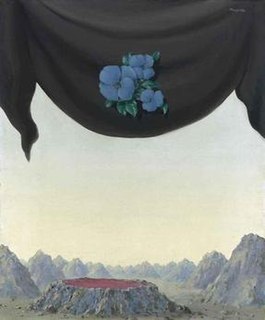
The Palace of Memories is a painting in oil on canvas, 46.2 × 38.2 cm, created in 1939 by Belgian surrealist artist René Magritte. It is held in a private collection.

Mervyn John Williams is a New Zealand artist. He was an early exponent of Op art in New Zealand in the 1960s–70s. In 1990 he originated a style of illusionary abstract painting based on chiaroscuro, creating the impression of three-dimensional forms and textures on a flat canvas. Since 2009 he has used digital techniques in returning to an Op art style. Williams is almost unique amongst his contemporaries in New Zealand art for having embraced abstraction at the start of his career and exclusively throughout. His work is held in all major New Zealand public collections. A monograph by Edward Hanfling was published by Ron Sang in 2014 coinciding with a survey exhibition.

The House series was produced by Roy Lichtenstein in the late 1990s and consists of several large-scale outdoor sculptures and an interior wall piece. The House series includes three distinct works: House I, House II, and House III. Each piece depicts the exterior of a simplified cartoon house, while actively producing an optical illusion. Houses I and III are available for display at the National Gallery of Art Sculpture Garden in Washington, D.C. and the High Museum of Art in Atlanta, GA, respectively. No records indicate the current location of House II.


















